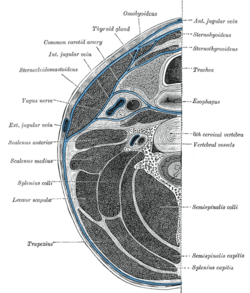Prevertebral space
| Prevertebral space | |
|---|---|
 Section of the neck at about the level of the sixth cervical vertebra. Showing the arrangement of the fascia coli. | |
 Sagittal section of nose mouth, pharynx, and larynx. | |
| Anatomical terminology |
The prevertebral space is a space in the neck.
On one side it is bounded by the prevertebral fascia.[1]
On the other side, some sources define it as bounded by the
longus colli.[1]
It includes the
In trauma, an increased thickness of the prevertebral space is a sign of injury, and can be measured with medical imaging.[4]
Clinical significance
On plain radiography, prevertebral space should be less than 6 mm at C3 vertebral level in children; while in adults, the space should be less than 6 mm at C2 level and less than 22 mm at C6 level. Causes of enlarged prevertebral space could be edema, hematoma, abscess, tumors, and post surgical changes.[5]
References
- ^ a b "eMedicine - Retropharyngeal Abscess : Article by Todd J Berger, MD". Retrieved 2008-02-18.
- ^ "Deep Neck Space Infections: Changing Trends". Archived from the original on March 19, 2007. Retrieved 2008-02-18.
- ^ "Prevertebral space cervical". Medcyclopaedia. GE.[dead link]
- ^ PMC 7051716.
- PMID 23153750.

![CT scan with upper limits of the thickness of the prevertebral space at different levels.[4]](http://upload.wikimedia.org/wikipedia/commons/thumb/d/d2/CT_of_prevertebral_space.jpg/151px-CT_of_prevertebral_space.jpg)